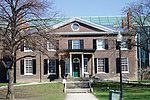Toronto Chinese Baptist Church

The Toronto Chinese Baptist Church is a Baptist church serving the Chinese-Canadian community of Toronto, Ontario, Canada. It was originally built as Beverley Street Baptist Church in 1880 as an outreach of Jarvis Street Baptist Church while the rest of the church was completed in 1886. Funding was largely donated by William McMaster and it is a designated historic building [1]. It overlooks The Grange that is today attached to the Art Gallery of Ontario. The church is located just to the east of the heart of Toronto's Chinatown. Chinese Baptists first met in the basement of the building in 1967. Five year later the church was purchased for the Chinese community with services being held in Cantonese. Today the church offers services in Cantonese, Mandarin and English. The growing Chinese-Canadian Baptist community has also led to the East Toronto, North Toronto, Mississauga and Scarborough Chinese Baptist Churches being established in Toronto's suburbs as well as the Windsor Chinese Baptist Church. Many of these daughter churches have in turn established daughter churches of their own further into the suburbs. Toronto Chinese Baptist Church is a member of the Baptist Convention of Ontario and Quebec.
Excerpt from the Wikipedia article Toronto Chinese Baptist Church (License: CC BY-SA 3.0, Authors, Images).Toronto Chinese Baptist Church
Beverley Street, Toronto
Geographical coordinates (GPS) Address External links Nearby Places Show on map
Geographical coordinates (GPS)
| Latitude | Longitude |
|---|---|
| N 43.651847 ° | E -79.393435 ° |
Address
Toronto Chinese Baptist Church
Beverley Street 72-74
M5T 1Y5 Toronto
Ontario, Canada
Open on Google Maps







